#SFP28 DAC Cable
Explore tagged Tumblr posts
Text

🚀 Enhance Your Network with the 25G SFP28 CWDM Optical Transceiver! 🌐
Looking for seamless and high-speed data transfer for your infrastructure? The 25G SFP28 CWDM 10km LC SMF Optical Transceiver is the perfect solution for boosting your network performance. With its reliable 25Gbps data rate and long-range capabilities, you’ll experience superior efficiency even in the most demanding environments.
Why Choose It? ✔️ 25G High-Speed for rapid data flow ✔️ 10km range for long-distance transmission over Single-Mode Fiber ✔️ Compact LC connector for ease of installation ✔️ Cost-Effective CWDM for efficient network upgrades
Time to level up your network! ⚡️
1 note
·
View note
Text
AddOn Juniper Networks QFX-QSFP28-SFP28-DAC-3M to Multiple OEM Compatible TAA Compliant 100GBase-CU QSFP28 to 4xSFP28 Direct Attach Cable (Passive Twinax, 3m)
AddOn Juniper Networks QFX-QSFP28-SFP28-DAC-3M to Multiple OEM Compatible TAA Compliant 100GBase-CU QSFP28 to 4xSFP28 Direct Attach Cable (Passive Twinax, 3m)

View On WordPress
0 notes
Link



#SFP28 Transceiver 25G#QSFP28 DAC Cable#SFP28 DAC Cable#QSFP28 Breakout DAC Cable#DWDM SFP+ Transceiver#Tunable DWDM SFP+
1 note
·
View note
Video
tumblr
We provide the best optical fibers products at our online Gbic-shop.de shop. One of the products includes QSFP Breakout Direct Attach Kabel, which converts simple signals into electromagnetic signals. Our company provides this product is very compatible and advisable rates with efficient cost. You can buy it or request a sample at Gbic-shop.de.
#direct attach kabel#QSFP Direct Attach Cables#SFP28 Direct Attach Kabel#QSFP28 DAC Cables#QSFP DAC Cables#OSFP DAC Kabel
0 notes
Text
Data Center Cabling Solution: Active Optical Cable
As data rates rise and data center grows in size, copper cable is getting stretched to its limits. However, active optical cable (AOC) has emerged to replace copper cable in data centers and high-performance computing (HPC) applications. It provides high-speed, high reliability, high flexibility, and low power consumption. This article will provide some knowledge of AOC cable.
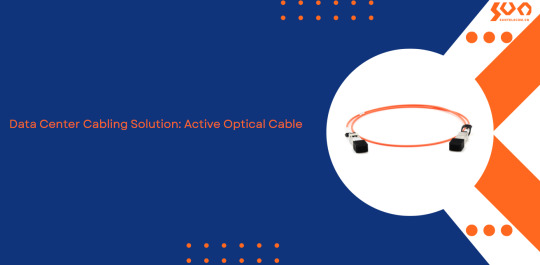
What is an Active Optical Cable?
Active optical cable (AOC) is an optical fiber jumper cable terminated with optical transceivers on both ends. It uses electrical-to-optical conversion on the cable ends to improve the speed and distance performance of the cable without sacrificing compatibility with standard electrical interfaces.
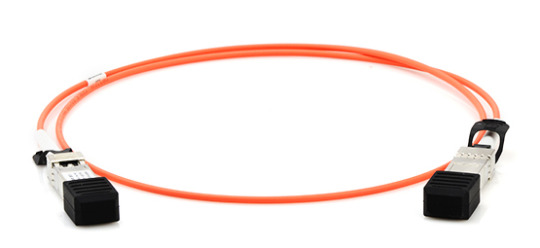
Active Optical Cable Structure
AOC cable consists of the fiber optic connector and fiber cable. The connection between fiber cable and fiber optic connectors is not separable. If the fiber optic connector or fiber cable needs to be changed, they should be removed together. The electrical and optical signal conversion can be achieved right through each end of the optical fiber.
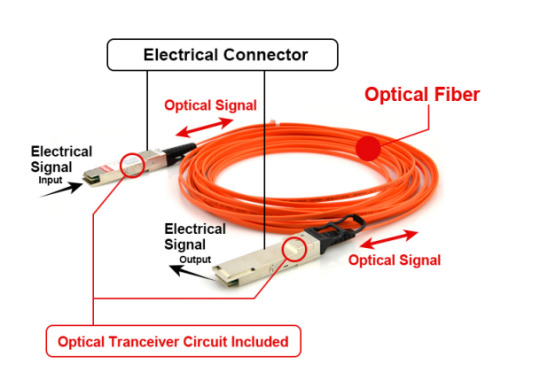
Active Optical Cable Types
There are several varieties of AOC cable available on the market , including 10G SFP+ AOC, 25G SFP28 AOC,40G QSFP+ AOC, 56G QSFP+ AOC, 40G QSFP+ to 4x SFP+ breakout AOC, 40G QSFP+ to 8x LC breakout AOC, 100G QSFP28 AOC, 100G QSFP28 to 4x SFP28 breakout AOC and 120G CXP AOC, etc. These AOC cables are commonly used for short-range multi-lane data communication and interconnect applications between two devices, such as rack-to-rack, shelf-to-shelf interconnect, storage, hubs, switches, routers, servers, etc.

Features and Benefits
AOC cable provides low power consumption, high density, high speed, high reliability, high security, small size, strong heat dissipation, low electromagnetic interference, long transmission distance, low energy consumption, low latency, lightweight, and ease of installation.
Application Scenarios
AOC Cable is used to connect top-of-row (ToR) switches to end-of-row aggregation switches, and to connect the ToR switch with storage subsystems at reaches greater than direct attach copper (DAC) limits of 3-7 meters. The following three scenarios show the specific applications.
Scenario 1: AOC cable is used to connect two switches directly.

Scenario 2: The breakout AOC cable provides a highly cost-effective way to connect within racks and across adjacent racks. The following figure shows 40GbE QSFP+ to 4 x SFP+ AOC cable connecting to a 40G QSFP+ port switch on one end, and to four 10G SFP+ port switches on the other end.
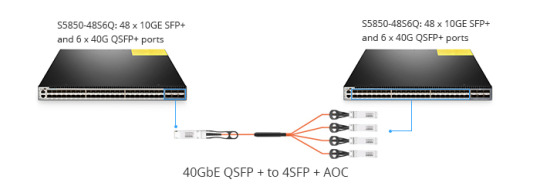
Scenario 3: For the long-haul transmission between the two switches, a suitable solution is recommended to use single-mode patch cable, OEO converters, and AOC cables, which can provide seamless integration of different fiber types by converting multi-mode fiber to single-mode fiber.
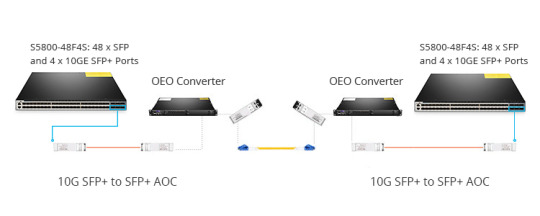
Conclusion
AOC cable achieves high data rates over long reaches interconnection, which is the best solution for data centers and high-performance computing applications. Sun Telecom specializes in providing one-stop total fiber optic solutions for all fiber optic application industries worldwide. Contact us if any needs.
2 notes
·
View notes
Text
25G Cabling Solutions: SFP28 Transceiver VS. SFP28 Twinax Cable VS. Cat8 Cable
Developed by IEEE 802.3 task force P802.3by, 25G Ethernet is a new standard for Ethernet connectivity in a data center environment. This standard was derived from 100G Ethernet standard, however, its operation works as a single lane connection with 25Gbps that can be run on fibers or coppers. To support 25G Ethernet, there are three most common cable solutions: SFP28 optical transceiver, SFP28 twinax cable and cat8 cable, which one is better for your 25G network? Please continue read the post, and you will find the answer.
SFP28 Transceiver
Fiber optic module and fiber patch cable are always the first choice in network connectivity. In this connection method, two things will be required: 25G SFP28 modules and duplex LC optical jumper. You need firstly plug the patch cable into SFP28 modules, then plug the whole assembly into the both devices. There are main two types of SFP28 transceivers used to transmit data across fiber optic cables with different maximum distances as shown in the following table.
Pros: SFP28 module and fiber cable is the best choice when the distance between two data center servers is very long.
Cons: Fiber and module is often more expensive than other two cabling solutions.
SFP28 Twinax Cable
Intended for short runs (up to 5 meters), SFP28 twinax cable or SFP28 direct attach twinax cable (DAC) is a cable assembly which is terminated with two SFP28 connectors at both ends. As the other DAC cables (eg: SFP+ DAC or QSFP+ DAC) that we are more familiar with, the SFP28 connector is also not real transceiver module, which doesn’t have expensive optical lasers, thus making this solutions more cost-effective than SFP28 transceiver solution. SFP28 twinax cable is ideal for high density, high speed I/O data center applications in the networking, telecom and data storage markets where maximum overall network efficiency and lower overall cost are desired.
Pros: It provides an extremely efficient increase in speed to top-of-server (ToR), and it is very suitable for very short links and offer a highly cost-effective way to establish a 25-Gigabit link between SFP28 ports of switches within racks and across adjacent racks.
Cons: Transmission distance is usually less than 10 meters.
25GBase-T: Cat8 Cable
While 25G over twinax DAC assemblies will fulfill the ToR server environment where a distance of 3 to 5 meters is more than adequate, there is also the need for longer distances to support the middle of the row (MoR) topologies to about 15m and end of row (EoR) to 30m. That’s where a 25GBase-T application over balanced twisted-pair copper cabling has potential to fill the gap. The Cat8 cabling is designed to support emerging 25GBase-T and 40GBase-T applications, which are specified over an extended bandwidth of 2GHz for a distance over 30 meters. It is fully backward compatible with Cat6a cabling, including RJ45 connectivity, and supports all Cat6a applications such as 10GBase-T for a distance of 100 meters.
Pros: Longer transmission distance than SFP28 twinax cable, up to 30 meters. Fully backward compatible with Cat6a cabling, which will provide easier migration from 1G to 10G to 25G.
Cons: The technology of 25GBase-T hasn’t been very mature yet, so there is not many devices that can support 25GBase-T standard.
Summary
Taking the advantages of high density and low cost consumption with no changes in architecture required, there is no doubt that 25G Ethernet will have a broad market potential in the server interconnect world. In the previous text, we have introduced three cabling solutions: 25G Ethernet over fiber, twinax and fiber. You can choose the right solution according to your demands.
0 notes
Text
Fiber NIC Card: Definition, Types and Applications
Network interface cards, which are also called fiber NIC cards. Fiber NIC cards can provide fast and reliable network connections for users computers or network servers. And there are several common types of network interface cards in the market, such as fiber NIC card and wireless network card. This article will shed light on fiber NIC cards and their different applications.
What Is Fiber NIC Card?
Fiber NIC card is also called fiber LAN card or fiber server adapter. It is like a circuit board which is designed to allow computers or servers to communicate with a network. The fiber network card has a unique physical network address, also referred to as a MAC address. Fiber NIC card is usually a separate adapter card that can be inserted into one of the server’s motherboard expansion slots. The side plate of the fiber NIC is usually built with an interface like SFP, SFP+ or QSFP+ port. The card can translate computer data into electrical signals and the signals are compatible with the network., which is easy to exchange information. In the next part, some common types of fiber optic NIC cards will be elaborated in detail.
Common Fiber NIC Card Types Overview
Gigabit fiber network card, 10G fiber network card, 25G fiber NIC card and 40G fiber NIC card are common types of fiber NIC cards. Some basic information about them will be elaborated in the following part.
Gigabit Fiber Network Card
The gigabit Ethernet fiber network card, which is also known as the 1000Mbps optical network card. Usually, its maximum transmission speed can reach 1000Mbps and only provide a fixed transmission speed. According to different bus interfaces, gigabit fiber network card can be divided into PCI gigabit network card, PCI-X gigabit network card and PCI express gigabit network card. Based on different network interfaces, it can be grouped into RJ-45 gigabit fiber network card and SFP gigabit fiber NIC card.
10G Fiber Network Card
10G fiber network card uses a 32/64-bit PCI bus network interface card to establish a connection between the PC and the switch to solve the bottleneck problem of the server network card in the intranet mode. SFP+ single mode or multimode fibers and DAC/AOC cable can be used in 10G fiber network cards. The integrated communication control chip of 10G fiber network card relieves the pressure of CPU data processing. And 10G fiber NIC cards, especially 10Gbase-t NIC card, are frequently used in computers due to its relatively low transmission speed.

25G Fiber NIC Card
25G fiber NIC card typically operates at the physical or data link layer and has a unique physical address (MAC address). In addition, the 25G fiber NIC card has one or two SFP28 ports on the side panel, which is mainly used to connect the optical module to the switch. Common SFP28 optical module or the SFP28 high-speed cable (DAC) can be used in 25G fiber NIC card. The 25G fiber NIC card is mainly used for the connection between the servers and the switches.

40G Fiber NIC Card
40G fiber NIC card has a 40G QSFP+ interface that supports 40Gbps transmission bandwidth. It supports the PCI-e x8 standard slot to ensure efficient and stable operation. Usually, the 40G fiber NIC card also has single port and dual ports. And 40G fiber NIC cards in some companies have different functions. For example, 40 Gigabit Ethernet adapters in Intel can provide traffic separation (VMS) for virtual machines, state offload and use server and network virtualization. While 40 Gigabit Ethernet adapters in Mellanox are the highest performing interconnect solution for enterprise data centers, cloud computing, high-performance computing, and embedded environments.

Application of Fiber NIC Cards
Fiber NIC cards have two major applications. They can be applied to the connection between network servers, computers or storage and switches to realize 10G, 25G, 40G or up to 100G data transmissions. Here gives a specific application scenario of 10G fiber NIC cards. Just show as the below picture. The 10GBASE-T network card connects the ToR switch or EoR usage models via Cat6a/Cat7 UTP cables.

Conclusion
From what has mentioned above, you may likely to have a general idea about different fiber NIC cards. When you decide to choose different fiber NIC cards, it is very important for you to find the suitable ones based on your own needs. FS provides products such as 10G, 25G, 40G fiber NIC cards at competitive prices. If you need any help, feel free to contact us at [email protected].
1 note
·
View note
Text
What are the differences between 25G DAC and AOC cable?
What are the differences between 25G DAC and AOC cable?
by http://www.fiber-mart.com 25G Ethernet has been hitting the web world at a sudden rate and may eventually become the fastest IEEE Ethernet standard ever completed. 25G cable is divided into 25G SFP28 direct attach cable and 25G SFP28 active optical cable, both of them can transmit data at 25Gbps. What are the differences between them? In this article, fiber-mart.com will focus on the…
View On WordPress
0 notes
Text
SFP vs. SFP+ vs. SFP28 vs. QSFP+ vs. QSFP28
Optical modules have many packaging types(form-factors). The reason why there are so many different packaging standards is mainly because the development speed of optical fiber communication technology is too fast. With the increasing speed and shrinking size of optical modules, new packaging standards will be issued every few years. It is often difficult to be compatible between old and new packaging standards. In addition, the diversity of application scenarios of optical modules is also a reason for the increase of packaging standards. Different transmission distances, bandwidth requirements and places of use will lead to different types of optical fibers and different optical modules.
1. SFP optical module
SFP optical module is a small hot-pluggable module encapsulated in SFP, with a maximum speed of 10.3G and an LC interface. Its volume is only 1 / 2 of that of GBIC module, which increases the port density of network equipment. In addition, the data transmission rate of SFP ranges from 100Mbps to 4gbps. SFP classification can be divided into rate classification, wavelength classification and mode classification.
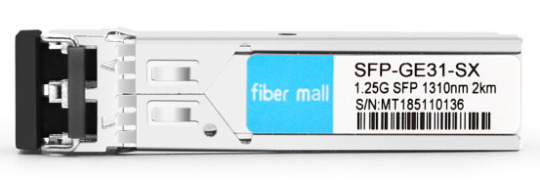
2. SFP+ optical module
SFP+ is an enhanced version of SFP and supports 8GBIT/s fibre channel, 10G Ethernet and optical transmission network standard otu2. In addition, SFP+ direct cable (i.e. SFP+ DAC high-speed cable and AOC active optical cable) can connect two SFP+ ports without adding additional optical modules and cables (network cable or optical fiber jumper), which is a good choice for the direct connection of two adjacent short-distance network switches.

3. SFP28 optical module
SFP28 is an enhanced version of SFP +, which has the same size as SFP +, but it can support the rate of single channel 25gb/s. Compared with 10G optical module, 25G SFP28 optical module has the best input/output performance and optical fiber capacity of 2.5 times, higher port density, and can save operation cost by reducing the number of tor switches and cables. SFP28 provides an efficient solution for 10G-25G-100G network upgrade, which can meet the growing needs of the next generation data center network.
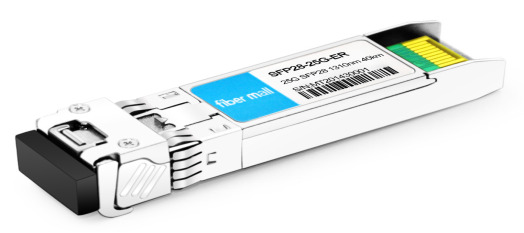
4. QSFP+ optical module
QSFP+ is an upgraded version of QSFP. QSFP can support 4-channel transmission at the same time. The data rate of each channel is 1GBIT/s, but QSFP+ is different from QSFP. It supports 4 channels × 10Gbit/s channel transmission, 40Gbps transmission rate can be realized through four channels. Compared with SFP +, the transmission rate of QSFP+ optical module can reach four times that of SFP + optical module. QSFP+ optical module can be directly used when deploying 40G network, so as to effectively save cost and improve port density.

5. QSFP28 optical module
QSFP28 is designed to meet 100G application requirements. It has four high-speed differential signal channels. The transmission rate of each channel ranges from 25Gbps to 40Gbps, which can meet 100G Ethernet (4× 25gbps) and EDR Infiniband. There are many types of QSFP28 products, and the ways to realize 100G transmission are different, such as 100G direct connection, 100G to 4-way 25G branch link or 100G to 2-way 50G branch link.

QSFP28 vs SFP28 : how different?
Although both SFP28 and QSFP28 have the number "28", their sizes and protocol standards are different. SFP28 supports 25gbit/s single channel, and QSFP28 supports four 25gbit/s channels. Both can be used in 100G network, but the use methods are different. QSFP28 can realize 100G transmission through the three methods mentioned above, but SFP28 needs to rely on QSFP28 to SFP28 branch high-speed cable.
0 notes
Text
What is a DAC cable? | Fibrecorss


A DAC (Direct Attach Cable) is a high-performance, cost-effective networking solution designed for short-range, high-speed data connectivity in data centers and enterprise environments. These twinaxial copper cables feature integrated transceivers on both ends, enabling seamless connections between switches, routers, servers, and storage devices without the need for separate optical transceivers. DAC cables support a variety of speeds, including 10Gbps (SFP+), 25Gbps (SFP28), 40Gbps (QSFP+), 100Gbps (QSFP28), 200Gbps (QSFP56), 400Gbps (QSFP-DD), and up to 800Gbps.DAC cables are ideal for applications requiring low latency and high bandwidth
2 notes
·
View notes
Text
Ubiquiti UniFi SFP DAC Patch Cable (UC-DAC-SFP28) кабель прямого подключения
Ubiquiti UniFi SFP DAC Patch Cable (UC-DAC-SFP28) кабель прямого подключения
Ubiquiti UniFi SFP DAC Patch Cable 25G (UC-PATCH-SFP-25G) – 0.5-метровый кабель прямого соединения, оконцованный 2-мя SFP28 разъемами, обеспечивающий скорость подключения до 25 Гбит/с. Характеристики Ubiquiti UniFi SFP DAC Patch Cable 25G (UC-PATCH-SFP-25G) Длина 0.5 метра Интерфейсы 2 x SFP28 Материал проводника нет данных Климатиче��кие условия эксплуатации температура от 0 до 70° C при…

View On WordPress
0 notes
Text
25G Switch Comparison: How to Choose the Suitable One?
Driven by the undeniable growth in demand for bandwidth of private and public cloud data centers, 25G Ethernet over a single lane has become the new trend for sever-to-switch interconnections. And the increasing requirements of higher speeds in data centers have enhanced the adoption of 25G switch, which is the new buzz in recent years. In this post, a simple analysis of 25G switch market and comparison of commonly used 25G switches will be explored.
25G Switch Market Analysis
As we know, before 25G technology advent, the existing options are one lane for 10G, four lanes for 40G, or four lanes at 25Gbps for 100G. The 25G technology meets the specification for existing module form factors like SFP28 and QSFP28, and allows for a breakout connection between 25G and 100G without changing the port on the front of many 100G switches. Besides, driven by the high speed and bandwidth, various switch manufacturers have announced their new 25G switches in recent three years, just to occupy more market shares.
Cisco delivered their Nexus 9300-FX platform switches for 10G/25G/100G switching;
Mellanox launched 25G Ethernet switch SN2410 series for 25G/50G/100G Ethernet networks;
Dell put forward EMC networking S-series 25/40/50/100GbE to help data centers migration;
Broadcom announced its BCM56960 Series 25G switch for cloud-scale networking;
FS.COM introduced N-Series spine/leaf 25G/100G switch for cost-effective data center solutions.
At the same time, 25G optical transceivers, DACs, and AOCs also spring up like mushrooms. According to a study by Dell’oro, Ethernet switch revenue will continue to grow through the end of the decade, with the biggest sales forecast for 25G and 100G ports.

Notes: the source of the research: Crehan research.Inc
From the research we can see, at least in the next three years, 25G/50G/100G bandwidth will continue to grow and occupy half of the total network bandwidth, which in turn enhances the development of 25G switch market. Though challenges still exist for 25G Ethernet, it’s not denied that the trend for ToR 25G switches cannot be blocked.
Comparison Between Commonly Used 25G Switches in the Market
As have mentioned above, 25G switch market is booming due to the growing speed and bandwidth as well as switch vendors promotion. Then how to achieve the optimized network performance with existing 25G Ethernet switches, and control the total investment at the same time? Firstly, let’s have a look at the 25G switches in the market.

All the 25G SFP28 switches listed in the table have the same port configuration: 48 SFP28 ports and 6 QSFP28 uplink ports. And there are ToR/Leaf switches. Usually 25G switch is often used for switch-to-server applications, as for how to realize this, please read the article: How to Use 25G Switch for Switch-to-Server Connection.
For choosing ToR 25G switch, if you have no limited cost budget, Cisco 25G switch maybe a not bad choice, because except for the expensive price, it has high-level performance and configuration as well as its good reputation. All these make Cisco switches are perfect for data centers. Of course, other 25G switch vendors like Dell, Brocade and Mellanox also provide good options for migration from 10G, 25G to 50G and 100G networks.
However, for those who have a tight budget or do not pursue brand, a more wise choices is to select 25G switch like FS.COM N8500-48B6C. This switch supports ONIE installer for 3rd party network operating systems and compatibility with SDN (Software Defined Networks) via OpenFlow 1.3.11. And it also supports the advanced hardware based VXLAN feature to support over 16M virtual networks, making it a suitable option for cost-effective data center solutions.

Summary
25G switch offers a more convenient way to migrate to 100G network. Because it reduces the numbers of cables and switches needed in network designs, which in turn decrease the CAPEX and OPEX. Facing with the fast evolving 25G switch market, are you ready for it?
1 note
·
View note
Text
25GBASE SFP28 DAC Cables
SFP28 cable, also known as SFP28 DAC (Direct Attach Copper ) Twinax cable or SFP28 AOC (Active Optical Cable) cable, is a form of a high-speed cable with SFP28 connector on either end. It features with lower power consumption and lower interconnection loss, which makes it suitable for TOR (Top-of Rack) switch to server connectivity.
The SFP28 cable can be classified to 25G SFP28 DAC cable and 25G SFP28 AOC cable. And they are all present to be the most economical choice for TOR 25GBASE switch connections. Here we will explain each cable one by one.
25G SFP28 DAC Cable
SFP28 DAC is a form of a shielded high-speed SFP28 cable with pluggable transceivers on either end. Generally, there are two popular types of SFP28 DACs on the market, 25G SFP28 to SFP28 DAC and 100G QSFP28 to 4 SFP28 DAC. 25G SFP28 to SFP28 DAC cable is usually a passive cable on the market. It has no signal amplification in the cable assembly, so it’s often used for ultra short reach (≤5m). 100G QSFP28 to 4 SFP28 DAC uses breakout cables connect to a 100G QSFP28 port switch on one end and four 25G SFP28 ports switch on the other end, making it a highly cost-effective way to achieve short distance. Normally 25G SFP28 DAC can be used to the interconnection of switches, routers, storage devices, and servers.

25G SFP28 AOC Cable
SFP28 AOC has a similar appearance as SFP28 copper cable, but its transmission method and application environment are not the same. There are two types of SFP28 AOCs on the market, 25G SFP28 to SFP28 AOC and 100G QSFP28 to QSFP28 AOC. SFP28 AOC uses electrical-to-optical conversion on the cable ends to improve speed and distance performance of the cable. Compared to the SFP28 copper cable, SFP28 AOC usually has a longer transmission distance and better transmission performance. Compared with the optical transceiver module, it does not have the problem of the interface being contaminated, which greatly improves the stability and reliability of the system and reduces the management costs of the server room. SFP28 AOC cable is the ideal cable for the connection between rack and rack on a data center, which is generally optimized for lengths.
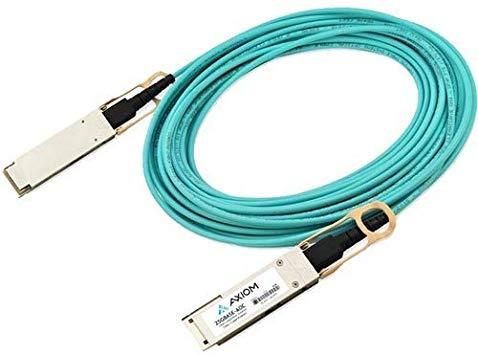
Features and benefits of Cisco 25G Modules
● Interoperable with other IEEE-compliant 25G interfaces where applicable
● Certified and tested on Cisco SFP28 ports for superior performance, quality, and reliability
● High-speed connectivity compliant to IEEE 802.3by and IEEE 802.3cc
The development of 25G SFP28 cable connections has provided a wide range of benefits, especially in a web-scale data center environment. Primarily, SFP28 cable is suitable for short-distance cabling of a network solution, which has a scientific layout design to save space with more reasonable length. It can efficiently utilize data and switch port density. Moreover, SFP28 cable provides an extremely efficient increase in speed to the server to TOR, especially when using the DAC assembly. It also simplifies the development of interoperability specifications and systems due to the fact that it is backward compatible and gives an easier upgrade path from an existing 10G TOR server configuration. Furthermore, using 25G SFP28 cables for TOR servers are more economical. This is because SFP28 cable can provide higher port densities, fewer TOR switches and cables are needed. It allows a more cost-effective alternative TOR server connection that connects via point-to-point links. It also enables EOR (End of Row) or MOR (Middle of Row) by using structured cabling.
Additional information
Are you looking for SFP28 DAC Cables and other fiber optics? As we know SFP28 DAC Cables is useful for short distance networking, so if you are searching for good quality DAC Cables then visit the web-address @ Gbic-shop.de.For more information about Cisco 25GBASE SFP28 optics and copper modules in details visit:- https://www.gbic-shop.de/SFP28-Direct-Attach-Kabel
References
https://www.unitymix.com/GBICSHOP
https://www.bagtheweb.com/b/9aAtvE
https://gbicshopde1.livejournal.com/843.html
https://dashburst.com/gbicshopde/9
https://list.ly/i/4421385
http://affiliated-business.com/story.php?title=buy-sfp56-direct-attach-kabel-from-our-online-web-address-gbic-shopde
https://www.worldranklist.com/preview/bookmarking/185646/Get-Reliable-Q28-502-transceiver-from-Gbic-shop-de-website
https://www.techsite.io/p/1383285
https://pr10.highdabookmarking.com/story.php?title=get-osfp-breakout-cables-from-gbic-shopde-at-low-price
http://www.ezyspot.com/node/411445
https://myspace.com/gbic.shop/mixes/streammix-724097/photo/373583067
https://gbicshopdethings.tumblr.com/post/190995788115/buy-sfp28-dac-cables-from-gbic-shopde
https://www.reddit.com/user/gbicshopde/comments/f8mzzc/get_high_performance_sfp28_dac_cables/
http://sco.lt/4hHYIK
http://www.pearltrees.com/gbic/item288859089
https://gbic.soup.io/
0 notes
Text
Direct Attach Cable VS. Active Optical Cable
Direct attach cable (DAC) and active optical cable (AOC) is crucial high-speed interconnect cabling solutions in data centers and high-performance computing applications. DAC and AOC cables are plug-and-play, allowing the users to optimize the existing network without new optical fiber cabling. This article will discuss the differences between DAC and AOC cables.
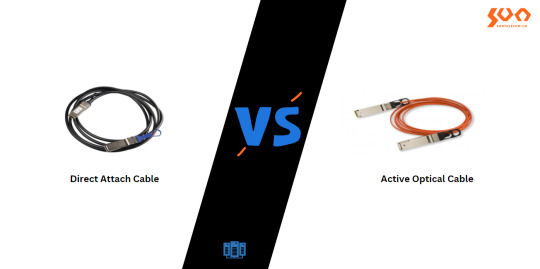
DAC Cable VS. AOC Cable
DAC cable consists of a Twinax copper cable terminated with SFP+/SFP28/QSFP+/QSFP56/QSFP28 connectors on both ends, which can provide an electrical connection directly to active equipment. DAC cable can be passive or active. Passive and active DAC cables can transmit electrical signals directly over copper cables. The passive DAC cable can deliver without signal conditioning, while the active DAC cable has electric components inside the transceivers to boost signals. AOC cable consists of a multi-mode fiber optic cable terminated with SFP connectors on both ends, which requires external power to complete the conversion of electric and optical signals, from electric signals to optical ones, and then convert to electric signals finally.
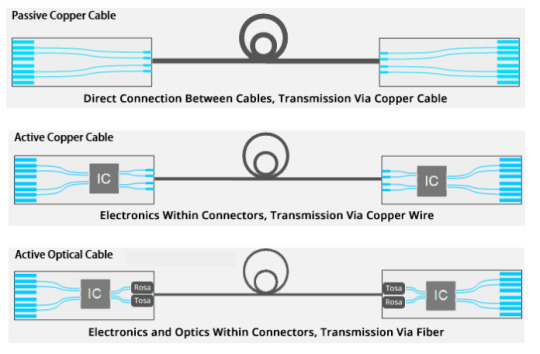
DAC and AOC cables differ from each other in the following aspects :
1. Power Consumption
Usually, the power consumption of an AOC cable is higher than a DAC cable, which is 1-2w. While the power consumption of active DAC cables is less than 1w, and the passive DAC cables cost nearly no power consumption at the value of lower than 0.15w due to the thermal design of DAC cables. As a result, the operating expenses on power consumption will be decreased when adopting the DAC options.
2. Transmission Distance
AOC cable can transmit over longer distances up to 100 m, while DAC cable link length limit is 10 m (passive DAC: 7 m; active DAC: 10 m). To sum up, DAC cable is suitable for short-range transmissions, while AOC cable is used for long-range transmissions.
Note: the max. distance of a signal that can be transmitted via a DAC cable changes depending on the data rate. The link length will decrease as the data rate grows, for example, 100G DAC cables can only transmit up to 5 meters.
3. Cost
In general, copper cables are much cheaper than fiber cables. When implemented in the high-density data center, the sum of money will be saved for large quantities of DAC cable compared to AOC cable.
4. Electromagnetic Interference Immunity
AOC cable is immune to electromagnetic interference, while DAC cable is vulnerable to the effect of electromagnetic interference, such as unwanted responses, degradation, or complete system failure.
5. Application
DAC cable is used to connect switches/servers to switches within racks and adjacent racks. In other words, DAC cable is used as an alternative for ToR (top of rack) interconnections between the ToR switch and server or the stacking of switches.

AOC Cable is used to connect ToR switches to EoR (end-of-row) aggregation switches, and to connect the ToR switch with MoR (middle-of-row) storage subsystems at reaches greater than DAC cable limits of 3-7 meters.

Conclusion
DAC and AOC cables are simple, cost-effective cabling solutions that are designed for the same ports as SFP+ or QSFP transceivers. DAC cable use copper-based cabling while AOC cable use fiber-based cabling. DAC cable provides lower power consumption and is cheaper than AOC cable. However, AOC cable provides long transmission distances than DAC cable. Sun Telecom specializes in providing one-stop total fiber optic solutions for all fiber optic application industries worldwide. Contact us if any needs.
1 note
·
View note